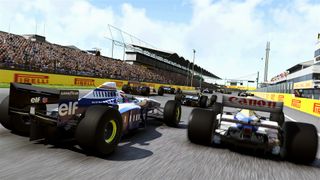12DOVE Verdict
F1 2017 is another superbly authentic recreation of modern F1. However, the sport’s current complexity will be overwhelming for most, and the returning classic content is nowhere near as good as it should be.
Pros
- +
The expanded, ultra-involved career mode
- +
Learning to drive properly yields huge rewards
- +
Looks slightly more naturalistic than F1 2016
Cons
- -
It’s become very complicated in order to satisfy fans
- -
Classic content is inferior to F1 2013’s
- -
The crashes are still underwhelming. F1 2010’s are better
Why you can trust 12DOVE
Real-world Formula One is often criticised for being too complicated. Like it or loathe it, the fuel-saving, tyre-managing, pit stop strategising tomfoolery is simply part of the modern sport, and isn’t going away any time soon. F1 2017 doesn’t even attempt to downplay all that. Instead, more than ever, it embraces every facet of the modern rules, and turns all that granular detail into a surprisingly enjoyable anti video game of smoothly playing the percentages instead of mindless spectacle. It’s the Niki Lauda of racing games. And Niki Lauda is awesome.
You’ll basically need to divide your brain down the middle to succeed. One half will drive the car, seeking the best racing line, feeding in power, changing gear (do it) and applying brakes with progressive control inputs (which are just fine on a pad – you don’t need a wheel), and lighting up the lap charts with purple sectors. The other half will be constantly monitoring the information readouts on the HUD. As with last year’s game, you can see from second-to-second whether you’re using too much fuel, thanks to projected laps remaining being shown to two decimal places. Manipulating the situation so that you end up with six laps’ worth of all-out boost at the end feels amazing, especially if you’ve saved some ultra-soft tyres for the final stint. This fuel readout holds sway over almost every aspect of your driving, and taming it until it does your bidding is a massively rewarding sub-game in its own right.

But there are so many more proverbial plates to keep spinning than fuel alone. Reliability is a more pressing consideration now, and since you’re limited to a set number of power units throughout the season, being too hard on your car will result in premature engine changes, for which you’ll incur a grid penalty. Fernando Alonso will shiver at the authenticity.
The game manages to teach you all of these conservative nuances through unobtrusively-integrated, enjoyable microgames to play. As with last year’s game, in the three pre-race practice sessions, you’re given scores to beat in short runs designed to gauge your driving style and teach you how to drive each course. The returning ‘acclimatisation’ challenge gives you gates around the track to teach you the racing line and the speed needed for optimum lap times, the familiar tyre management and new fuel-saving runs test to see whether you’re being gentle enough on the car and the controls, and the qualifying simulation lets you see how competitive your best effort really is. But even better than simply teaching and testing you, there are two further benefits. Firstly, your actual data from the new race strategy programme is analysed and translated into a suggested strategy for the Grand Prix itself. More stops for hard racers, fewer for the more measured drivers. And secondly, by completing these challenges, you earn Research & Development points to spend on upgrading your car.
The R&D section is massively expanded for this year’s game. With an RPG-like skill tree system, you’ll gradually spend your points on some of the 115 available upgrades, like new aerodynamic elements or something less tangible, like reliability. There is a chance development on a component will go wrong – something you can minimise by spending early points on improving the odds of a successful development. F1 teams are always ‘running to stand still’, so while you’re spending points on one area, other teams are already seeing success in another. Don’t worry, though, you now get ten years of career to level it all up. And if it’s all too much, there’s a ‘recommended’ button to do it for you. Easy.

As you’ve probably guessed by now, there’s no point in me arguing that ‘anyone can enjoy the game regardless of skill or knowledge of the sport’, as I have easily been able to do with every past iteration. F1 2017 is all about the career mode and that is clearly tailored towards hardcore F1 fans. If that’s not you, even though you just play plain old ‘Championship mode’, foregoing all the new R&D stuff, this probably isn’t the game for you. The core racing isn’t spectacular enough or simple enough to enthral casual players.
Conversely, if you live and breathe Formula One, there’s nothing even close on any console. From the compelling ‘rivalry’ system that gives each qualifying and race result obvious repercussions, to downloadable scenario challenges with leaderboards to keep the game fresh, there’s always something teasing your competitive instinct. There are small improvements everywhere you look, like the more assured handling model in wet weather making for more fun and competitive wet races, and graphical tweaks that bring more realistic replay footage and better human likenesses.
But there is one severe mis-step that will likely dismay the game’s target audience, and that’s the returning ‘classic’ content. Last seen in the utterly stupendous F1 2013, iconic cars from yesteryear are playable here, including Nigel Mansell’s FW14B from 1992, several gorgeous Ferraris from the ’90s and early 2000s, and you can even drive the all-conquering 1988 McLaren MP4/4, as driven by Ayrton Senna and Alain Prost... if you buy the special edition or DLC.

However, classic drivers are not featured this time around, which immediately halves the appeal. There are 20 ‘invitational’ events throughout career mode, replayable once unlocked, or you can just enter classic events in each menu option. But with cigarette advertising understandably removed and no classic driver helmets to complete iconic imagery, disappointingly tame engine sounds, and DRS signs still in place at the trackside, it feels decidedly half-baked. Given the pre-release trailer campaign, it seemed like Classic Mode was going to be amazing, but that just isn’t the case. It’s basically a car pack.
The reality, however, is that those players old enough to remember Formula One’s golden age in detail are now a niche within a niche. And if you love the sport as it is today, the disappointing Classic content won’t really matter. You’ll be utterly engulfed by F1 2017’s phenomenal, exhaustive recreation of a massively complex motorsport. It’s the best F1 experience on current-gen and sets the bar for every other officially-licensed racing game. Watch your fuel, though, yeah? WATCH IT.
More info
| Genre | Racing |
Justin was a GamesRadar staffer for 10 years but is now a freelancer, musician and videographer. He's big on retro, Sega and racing games (especially retro Sega racing games) and currently also writes for Play Magazine, Traxion.gg, PC Gamer and TopTenReviews, as well as running his own YouTube channel. Having learned to love all platforms equally after Sega left the hardware industry (sniff), his favourite games include Christmas NiGHTS into Dreams, Zelda BotW, Sea of Thieves, Sega Rally Championship and Treasure Island Dizzy.













Astro Bot went through 23 pitch iterations before its director promised PlayStation "happy gameplay" and "overflowing charm," though it did once end with robot decapitation that made "some people really upset"

5 years after Avengers, 2 years after its last layoffs, and who knows how long before Perfect Dark and Tomb Raider return, Crystal Dynamics announces another round of layoffs

Charlie Brooker promises Black Mirror season 7 is "a bit more OG", having previously said that he didn't want the series to be known as "the 'tech is bad' show" anymore





